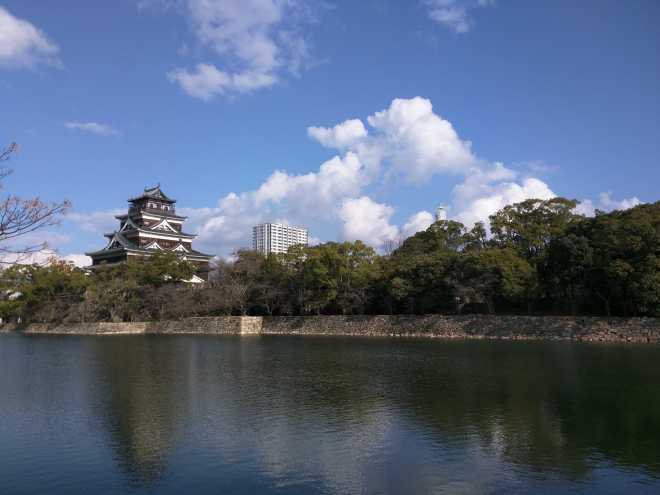We arrived in Kyoto late in the evening of the 23rd and immediately booked our Shinkansen tickets (wooohoo, JR Pass!) for Hiroshima the next day. As we were nearing the holidays, we were afraid tourist attractions would shut down and had to plan our sight-seeing around that. But fret not, as we still had plenty of time for Kyoto (as you’ll see in the upcoming posts).
Now, Hiroshima… for those who don’t know (and I really well hope that you do…), on August 6th, 1945 the U.S. dropped the first ever atomic bomb on the city of Hiroshima, killing almost 70,000-80,000 people (around 30% of the population of Hiroshima) in the blast & subsequent firestorm, and thousands more in the months (and years) that followed as a result of the nuclear fallout (radiation), bringing the total death-toll to over 150,000. Three days later, the U.S. dropped the second ever atomic bomb on Nagasaki, killing over 75,000. These two events (the only use of atomic weapons in world history) essentially brought World War II to an end. This is, of course, a gross simplification of events and should you want to learn more, crack open a book, cus a full-on history lesson is far from the point of this blog. However, as the visit to Hiroshima and the Hiroshima Peace Memorial Museum was immensely powerful, we did decide that it deserved a blog post of its own and will thus include some of the highlights (not sure that’s the right word, since I wouldn’t exactly classify this as a “high”) from our visit.
We finished the day off on a lighter note, by visiting the beautiful island of Itsukushima and the Itsukushima Shrine.
Hope we were able to adequately convey the power of Hiroshima and the beauty of Itsukushima with the photos below.
Miles walked: 5
Miles transported: ~450
Hiroshima
Arrived at the Hiroshima Peace Memorial Museum. The entrance to the exhibit:
A small scale (obviously) model of Hiroshima at the time of the bomb’s detonation, 580 meters above the city center:
Replica of the atomic bomb that was dropped, code-named “Little Boy“. This “Little Boy” achieved a blast radius of 1 mile, ultimately claiming over 150,000 lives:
These were pretty much the only picture we took from inside the exhibit, as frankly it was not easy to look at, let alone capture, the rest.
As we made our way out of the exhibit, photographs commemorating the visits of influential people from around the world were displayed. Interestingly enough, Frederic W. de Klerk (former South African President) and Shimon Peres (former Israeli Prime Minister) were displayed side-by-side:
Leaving the exhibit, we see archaeologists unearthing the ground beneath the museum, as recent excavations have begun to identify pre-war remains thought to be lying under the museum:
Walking through Hiroshima Peace Memorial Park:
The Hiroshima National Peace Memorial Hall, located directly below the blast site of the bomb, displays names, stories and memories of victims and survivors:
The Children’s Peace Memorial, established to commemorate Sadako Sasaki (and fellow child victims of the bomb), who died of leukemia from the radiation of the bomb. While in the hospital, she spent her days creating paper cranes (a symbol of peace), as Japanese tradition says that if one creates a thousand cranes, they are granted one wish. She ended up creating 1,400 cranes, in the hopes of realizing her dying wish, which was peace. Today, thousands of children from around the world create and send paper cranes to this memorial in honor of Sadako and the thousands of other children that perished:
The Hiroshima Peace Clock Tower, which chimes every single day at 8:15am, the exact time the bomb went off:
And finally, the Hiroshima Peace Memorial, more commonly called the Atomic Bomb Dome. Formerly the Product Exhibition Hall building of Hiroshima, this building (or what’s left of it) was the only structure left standing near the bomb’s hypocenter (the bomb exploded almost directly above this building). Furthermore, as all the ruins from the bomb were demolished and rebuilt, this is the only ruin left preserved (though with much controversy) as a memorial to the people killed in the blast:
Leaving behind (but certainly not forgetting) the death, horror and destruction, we made our way to the train station for our next destination, passing by the beautiful Hiroshima Castle on the way:
Itsukushima
Itsukushima is an island in the Hiroshima Bay, famous for the Itsukushima Shrine, a UNESCO World Heritage Site. It is more popularly known as Miyajima, which literally means “Shrine Island” in Japanese. We took the JR ferry (ALSO covered by the JR Pass… what?!) to the island, capturing these gorgeous views along the way:
The “floating” torii gate of the Itsukushima Shrine (though it wasn’t exactly “floating”, as the tide was low):
Miyajima island is literally COVERED in deer, just walking about and hanging out:
We tried to get them to play with Samsonite, but this wasn’t just wasn’t having it. He must be racist against turtles:
This one, however, much different story:
Mandatory deer selfie (delfie?):
Making our way over to the shrine, sneaking in a shot of these slutty santas off-duty:
The torii gate:
The shrine’s five-tiered pagoda:
The shrine (we didn’t actually go in, as we were too cheap, but managed to get some cool shots from the outside):
Making our way over to the gate for a close-up shot, which turned out to be much more of a challenge than anticipated:
Success!
Heading back to our ferry through the little town of Itsukushima, home to the world’s largest shamoji (rice paddle). And guess what? This is where the shamoji was invented!! Ya, this fun little fact just made you THAT much more interesting to talk to at dinner parties. Naturally, we had to go next door and buy one (a slightly smaller one):






































